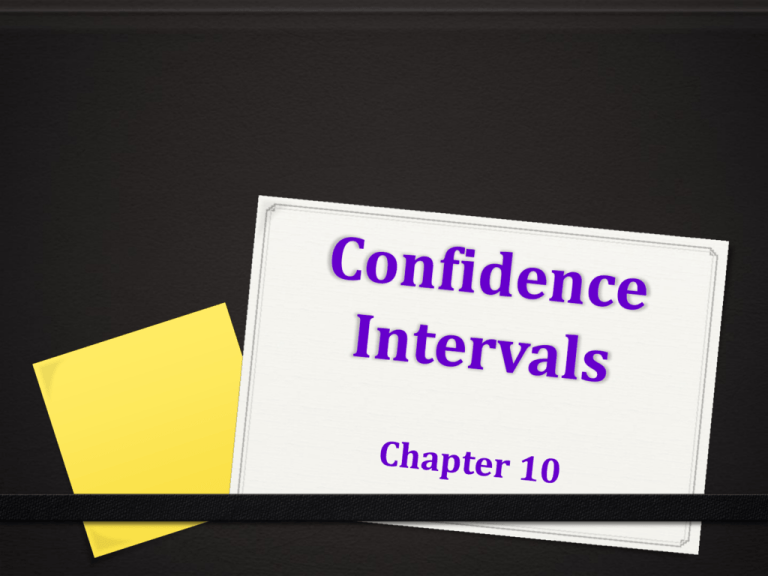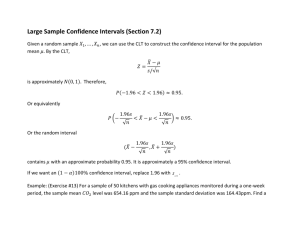Ch10 Confidence Intervals
advertisement

Rate your confidence 0 - 100 0 Name my age within 10 years? 0 within 5 years? 0 within 1 year? 0 Shooting a basketball at a wading pool, will make basket? 0 Shooting the ball at a large trash can, will make basket? 0 Shooting the ball at a carnival, will make basket? What happens to your confidence as the interval gets smaller? The larger your confidence, the wider the interval. Simulation Point Estimate 0Use a single statistic based on sample data to estimate a population parameter 0Simplest approach 0But not always very precise due to variation in the sampling distribution Confidence intervals 0Are used to estimate the unknown population mean 0Formula: estimate + margin of error Margin of error 0 Shows how accurate we believe our estimate is 0 The smaller the margin of error, the more precise our estimate of the true parameter 0 Formula: critical m value standard deviation of the statistic Confidence level 0Is the success rate of the method used to construct the interval 0Using this method, ____% of the time the intervals constructed will contain the true population parameter Critical value (z*) 0 Found from the confidence level 0 The upper z-score with probability p lying to its right under the standard normal curve z*=1.645 z*=1.96 z*=2.576 Confidence level tail area z* .05 1.645 .05 90% .025 95% 99% .025 .005 1.96 2.576 .005 What does it mean to be 95% confident? 095% chance that m is contained in the confidence interval 0The probability that the interval contains m is 95% 0The method used to construct the interval will produce intervals that contain m 95% of the time. Confidence interval for a Standard populationCritical mean: deviation of the value statistic x z * n estimate Margin of error Steps for doing a confidence interval: 1) Assumptions – • • SRS from population Sampling distribution is normal (or approximately normal) 0 0 0 • Given (normal) Large sample size (approximately normal) Graph data (approximately normal) is known 2) Calculate the interval 3) Write a statement about the interval in the context of the problem. Statement: (memorize!!) We are ________% confident that the true mean context lies within the interval ______ and ______. A test for the level of potassium in the blood is not perfectly precise. Suppose that repeated measurements for the same person on different days vary normally with = 0.2. A random sample of three has a mean of 3.2. What is a 90% confidence interval for the mean potassium level? Assumptions: Have an SRS of blood measurements Potassium level is normally distributed (given) known .2 3.0101, 3.3899 3.2 1.645 3 We are 90% confident that the true mean potassium level is between 3.01 and 3.39. 95% confidence interval? Assumptions: Have an SRS of blood measurements Potassium level is normally distributed (given) known .2 2.9737, 3.4263 3.2 1.96 3 We are 95% confident that the true mean potassium level is between 2.97 and 3.43. 99% confidence interval? Assumptions: Have an SRS of blood measurements Potassium level is normally distributed (given) known .2 3.2 2.576 2.9026,3.4974 3 We are 99% confident that the true mean potassium level is between 2.90 and 3.50. What happens to the interval as the confidence level increases? the interval gets wider as the confidence level increases Critical value (z*) 0 Found from the confidence level 0 The upper z-score with probability p lying to its right under the standard normal curve z*=1.645 z*=1.96 z*=2.576 Confidence level tail area z* .05 1.645 .05 90% .025 95% 99% .025 .005 1.96 2.576 .005 How can you make the margin of error smaller? 0 z* smaller (lower confidence level) 0 smaller (less variation in the population) Really cannot 0 n larger change! (to cut the margin of error in half, n must be 4 times as big) A random sample of 50 BGHS students was taken and their mean SAT score was 1250. (Assume = 105) What is a 95% confidence interval for the mean SAT scores of BGHS students? We are 95% confident that the true mean SAT score for BGHS students is between 1220.9 and 1279.1 Find a sample size: 0 If a certain margin of error is wanted, then to find the sample size necessary for that margin of error use: m z * n Always round up to the nearest person! The heights of BGHS male students is normally distributed with = 2.5 inches. How large a sample is necessary to be accurate within + .75 inches with a 95% confidence interval? n = 43 Homework pg. 632-633 711, 13, 15 t- distribution 0 Developed by William Gosset 0 Continuous distribution 0 Unimodal, symmetrical, bell-shaped density curve 0 Above the horizontal axis 0 Area under the curve equals 1 0 Based on degrees of freedom Graph examples of t- curves vs normal curve How does t compare to normal? 0Shorter & more spread out 0More area under the tails 0As n increases, t-distributions become more like a standard normal distribution How to find t* Can also use invT on the calculator! Need upper t* value with 5% is above – 0 Use Table B forso t distributions 95% is below 0 Look up confidence level at bottom & df on the sides 0 df = n – 1 invT(p,df) Find these t* 90% confidence when n = 5 95% confidence when n = 15 t* =2.132 t* =2.145 Formula: Standard deviation of Critical value statistic Confidence Interval : s x t * n estimate Margin of error Assumptions for t-inference 0 Have an SRS from population 0 unknown 0 Normal distribution 0 Given 0 Large sample size 0 Check graph of data Robust 0 An inference procedure is ROBUST if the confidence level or p-value doesn’t change much if the assumptions are violated. 0 t-procedures can be used with some skewness, as long as there are no outliers. 0 Larger n can have more skewness. 0 Outliers are always a concern, but they are even more of a concern for confidence intervals using the t-distribution 0 Sample mean is not resistant; hence the sample mean is larger or smaller (drawn toward the outlier) (small numbers of n in t-distribution!) 0 Sample standard deviation is not resistant; hence the sample standard deviation is larger 0 Confidence intervals are much wider with an outlier included 0 Options: 0 Make sure data is not a typo (data entry error) 0 Increase sample size beyond 30 observations A medical researcher measured the pulse rate of a random sample of 20 adults and found a mean pulse rate of 72.69 beats per minute with a standard deviation of 3.86 beats per minute. Assume pulse rate is normally distributed. Compute a 95% confidence interval for the true mean pulse rates of adults. We are 95% confident that the true mean pulse rates of adults is between 70.883 and 74.497 beat per minute. Another medical researcher claims that the true mean pulse rate for adults is 72 beats per minute. Does the evidence support or refute this? Explain. The 95% confidence interval contains the claim of 72 beats per minute. Therefore, there is no evidence to doubt the claim. Consumer Reports tested 14 randomly selected brands of vanilla yogurt and found the following numbers of calories per serving: 160 200 220 230 120 180 140 130 170 190 80 120 100 170 Compute a 98% confidence interval for the average calorie content per serving of vanilla yogurt. We are 98% confident that the true mean calorie content per serving is between 126.16 and 189.56 calories. A diet guide claims that you will get 120 calories from a serving of vanilla yogurt. What does this evidence indicate? Note: confidence intervals tell us if something is NOT EQUAL – never less or greater than! Since 120 calories is not contained within the 98% confidence interval, the evidence suggest that the average calories per serving does not equal 120 calories. Some Cautions: 0The data MUST be a SRS from the population 0The formula is not correct for more complex sampling designs, i.e., stratified, etc. 0No way to correct for bias in data Cautions continued: 0Outliers can have a large effect on confidence interval 0Must know to do a z-interval – which is unrealistic in practice 0Homework: 010.27, 28, 29 0Pg.648-649







